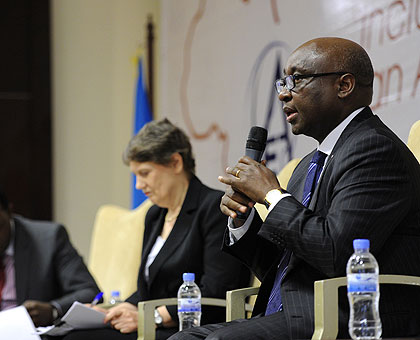As Kigali gears up to host the 49th General Assembly of the African Development Bank (AfDB), The New Times continues to run a series of stories about the continental financial support institution and its significance to Africa. Today, Eugene Kwibuka looks at the key personalities in AfDB’s history.


As Kigali gears up to host the 49th General Assembly of the African Development Bank (AfDB), The New Times continues to run a series of stories about the continental financial support institution and its significance to Africa. Today, Eugene Kwibuka looks at the key personalities in AfDB’s history.
At 50, the African Development Bank (AfDB) continues to exist because many people played a big role in both creating and keeping it up and running.
One of the most notable people in the life of the Bank is Romeo Horton, a Liberian banker who was the brain behind its establishment.
Formerly head of what is today’s Ministry of Commerce and Industry in Liberia, and a man who was committed to economic cooperation in West Africa, Horton pitched the idea of forming AfDB to his President William Tubman in the 1960s.
Tubman welcomed the idea and Horton went ahead with presenting it to other African and global leaders.
Horton led a working group known as "the Committee of Nine”— a sort of think-tank and steering committee made up of financial experts and economists from nine African countries—to present their idea of an African development bank to all African heads of State as well as Western and Eastern leaders.
As a pioneer of AfDB, Horton is known for having always promoted the idea that the Bank should be an African originality that would be free from "cold war” caused by rivalry between Russian communism and Western capitalism.
Another notable figure in the early years of the AfDB is Mamoun Beheiry, who was the first president of the Bank–in 1964.
The former governor of Sudan’s central bank is also remembered for strongly backing the idea of an independent AfDB and for his outstanding devotion to the continent’s development.
In the years of humble beginnings of the AfDB in the 1960s, the name of George Wood, the then president of the World Bank, could not go unnoticed.
Office and cooperation
That’s because he offered the help of his organisation’s regional office in Abidjan, Ivory Coast, to AfDB where the latter carried out its first projects.
Officials at the Bank say accepting to use the office offered by the World Bank marked the beginning of the principle of cooperation with other development finance institutions.
Before the AfDB’s current president, Dr Donald Kaberuka, a Rwandan, took over leadership in 2005, the Bank had had six presidents and one caretaker president since its inception.
Dr Kaberuka said in a speech last month that the AfDB had 10 staff and a capital of $ 250 million (about Rwf169 billion) at its inception on September 10, 1964.
"We salute men such as Romeo Horton… those beginnings for the Bank were not so easy,” Dr Kaberuka said at the launch of the 50th anniversary celebrations of the Bank last month.
By the end of 2011, the Bank had been involved in more than 3,600 loans and grants amounting to $92 billion (about Rwf62 trillion).
The Bank’s Board of Governors sits at the top of its organisational structure and meets annually to review the implementation of past policy decisions and deliberate on new issues.
Rwanda’s Finance and Economic Planning minister Claver Gatete has been the chairperson of the Bank’s Board of Governors since May last year and is expected to hand over the seat to a new appointee during the meeting in Kigali next week.
Achievements of the AfDB in financing Africa in the past 50 years and the Bank’s focus for the future will be at the centre of discussions at its 49th annual assembly due in Kigali next week.


